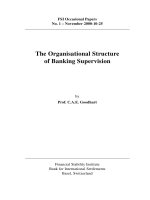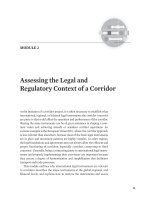Lecture Legal and regulatory aspects of banking supervision – Chapter 7
Bạn đang xem bản rút gọn của tài liệu. Xem và tải ngay bản đầy đủ của tài liệu tại đây (69.67 KB, 34 trang )
Session:
SEVEN
MBF-705
LEGAL AND REGULATORY
ASPECTS OF BANKING
SUPERVISION
OSMAN BIN SAIF
Summary of Previous Session
•
General Types of Bank Regulations
•
Privacy Regulations
•
Anti-money laundering and anti-terrorism
regulation
•
Community re-investment regulation
•
Deposit account regulation
•
Deposit insurance regulation
•
Consumer protection
2
Summary of Previous Session
(Contd.)
•
Interest on demand deposits
•
Lending Regulations
–
Consumer protection
–
Debt collection
–
Credit cards
–
Lending limits
•
Central bank regulations
•
Regulation of bank affiliates and3 holding
Agenda of this session
•
•
•
SECTION 2:
REGULATING BANK CAPITAL
ADEQUACY
–
What is Capital Adequacy
–
Regulations
–
5C’s of Credit
Regulatory Capital
–
Tier 1 Capital
4
Agenda of this session (Contd.)
•
General Provisions
•
Hybrid Debt Capital Instrument
•
Sub-ordinated term debt
•
Different international implementations
5
•
•
SECTION 2:
REGULATING BANK CAPITAL
ADEQUACY
6
CAPITAL ADEQUACY
•
•
Capital requirement (also known
as Regulatory capital or Capital
adequacy) is the amount of capital
a bank or other financial institution has to
hold as required by its financial regulator.
This is usually expressed as a capital
adequacy ratio of equity that must be held
as a percentage of risk-weighted assets.
7
CAPITAL ADEQUACY (Contd.)
•
•
•
These requirements are put into place to
ensure that these institutions do not take
on excess leverage and become
insolvent.
Capital requirements govern the ratio of
equity to debt, recorded on the right side
of a firm's balance sheet.
They should not be confused with reserve
requirements, which govern the left side of
8
a bank's balance sheet--in particular,
the
Regulations
•
•
A key part of bank regulation is to make
sure that firms operating in the industry
are prudently managed.
The aim is to protect the firms themselves,
their customers and the economy, by
establishing rules to make sure that these
institutions hold enough capital to ensure
continuation of a safe and efficient market
and able to withstand any foreseeable
problems.
9
Regulations (Contd.)
•
•
The main international effort to establish
rules around capital requirements has
been the Basel Accords, published by
the Basel Committee on Banking
Supervision housed at the Bank for
International Settlements.
This sets a framework on
how banks and depository
institutions must calculate their capital.
10
Regulations (Contd.)
•
•
In 1988, the Committee decided to
introduce a capital measurement system
commonly referred to as Basel I.
This framework has been replaced by a
significantly more complex capital
adequacy framework commonly known
as Basel II.
•
After 2012 it was replaced by Basel III.
•
Another term commonly used in 11the
Regulations (Contd.)
•
•
The capital ratio is the percentage of a
bank's capital to its risk-weighted assets.
Weights are defined by risk-sensitivity
ratios whose calculation is dictated under
the relevant Accord. Basel II requires that
the total capital ratio must be no lower
than 8%.
12
Regulations (Contd.)
•
•
Each national regulator normally has a
very slightly different way of calculating
bank capital, designed to meet the
common requirements within their
individual national legal framework.
Most developed countries implement
Basel I and II and now III , stipulate
lending limits .
13
Regulations (Contd.)
•
•
The 5 Cs of Credit - Character, Cash Flow,
Collateral, Conditions and Capital- have
been replaced by one single criterion.
While the international standards of bank
capital were laid down in the 1988 Basel
I accord, Basel II makes significant
alterations to the interpretation, if not the
calculation, of the capital requirement.
14
Regulations (Contd.)
•
•
Examples of national regulators
implementing Basel II include the FSA in
the UK, BaFin in Germany, OSFI in
Canada, Banca d'Italia in Italy, State bank
in Pakistan.
In the European Union member states
have enacted capital requirements based
on the Capital Adequacy Directive CAD1
issued in 1993 and CAD2 issued in 1998.
15
Regulations (Contd.)
•
•
In the United States, depository
institutions are subject to risk-based
capital guidelines issued by the Board of
Governors of the Federal Reserve
System (FRB).
These guidelines are used to evaluate
capital adequacy based primarily on the
perceived credit risk associated
with balance sheet assets, as well as
certain off-balance sheet exposures
such
16
Regulations (Contd.)
•
•
The risk-based capital guidelines are
supplemented by a leverage
ratio requirement.
To be adequately capitalized under federal
bank regulatory agency definitions, a bank
holding company must have a Tier 1
capital ratio of at least 4%, a combined
Tier 1 and Tier 2 capital ratio of at least
8%, and a leverage ratio of at least 4%,
and not be subject to a directive,17order, or
Regulations (Contd.)
•
To be well-capitalized under federal bank
regulatory agency definitions, a bank
holding company must have a Tier 1
capital ratio of at least 6%, a combined
Tier 1 and Tier 2 capital ratio of at least
10%, and a leverage ratio of at least 5%,
and not be subject to a directive, order, or
written agreement to meet and maintain
specific capital levels.
18
Regulations (Contd.)
•
These capital ratios are reported quarterly
on the Call Report or Thrift Financial
Report. Although Tier 1 capital has
traditionally been emphasized, in the Late2000s recession regulators and investors
began to focus on tangible common
equity, which is different from Tier 1 capital
in that it excludes preferred equity.
19
Regulatory capital
•
In the Basel II accord bank capital has
been divided into two "tiers" , each with
some subdivisions.
20
Tier 1 capital
•
Tier 1 capital, the more important of the
two, consists largely of shareholders'
equity and disclosed reserves. This is the
amount paid up to originally purchase the
stock (or shares) of the Bank (not the
amount those shares are currently trading
for on the stock exchange), retained
profits subtracting accumulated losses,
and other qualifiable Tier 1 capital
securities .
21
Tier 1 capital (Contd.)
•
In simple terms, if the original stockholders
contributed $100 to buy their stock and
the Bank has made $10 in retained
earnings each year since, paid out no
dividends, had no other forms of capital
and made no losses, after 10 years the
Bank's tier one capital would be $200.
Shareholders equity and retained earnings
are now commonly referred to as "Core"
Tier 1 capital, whereas Tier 1 is core
Tier
1
22
Tier 2 (supplementary) capital
•
Tier 2 capital, or supplementary capital,
comprises undisclosed reserves,
revaluation reserves, general provisions,
hybrid instruments and subordinated term
debt.
23
Undisclosed Reserves
•
Undisclosed reserves are not common,
but are accepted by some regulators
where a Bank has made a profit but this
has not appeared in normal retained
profits or in general reserves.
24
Revaluation reserves
•
•
A revaluation reserve is a reserve created
when a company has an asset revalued
and an increase in value is brought to
account.
A simple example may be where a bank
owns the land and building of its
headquarters and bought them for $100 a
century ago. A current revaluation is very
likely to show a large increase in value.
The increase would be added to25a









